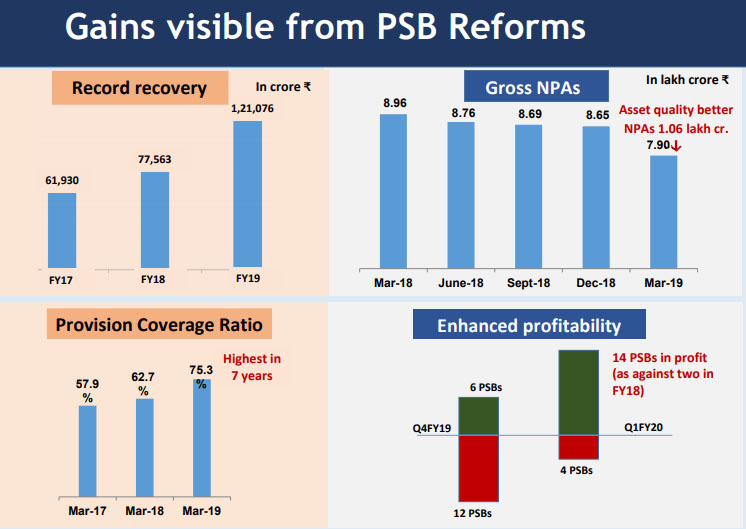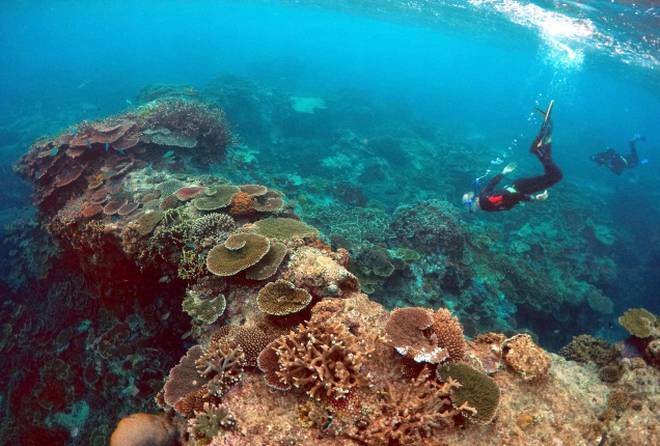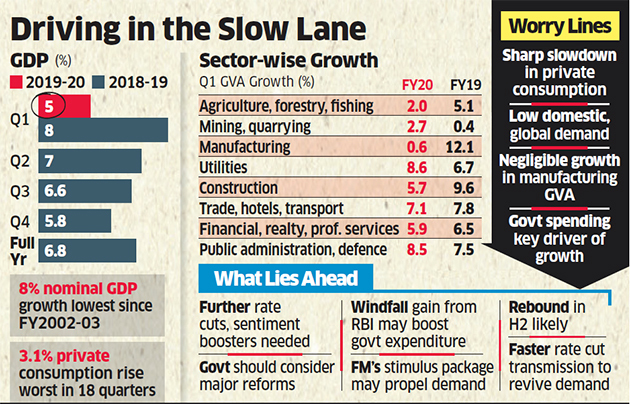Indian Economy
Amalgamation of National Banks
The Finance Minister has announced the biggest consolidation plan of Public sector Banks (PSBs)- merging 10 of them into just 4.
New Banks After the Merger
| Sr. No. | Amalgamated Banks | Anchor Banks |
| 1 | Punjab National Bank (PNB), Oriental Bank of Commerce (OBC), and United Bank of India | PNB |
| 2 | Canara Bank and Syndicate Bank | Canara Bank |
| 3 | Union Bank of India, Andhra Bank, and Corporation Bank | Union Bank of India |
| 4 | Indian Bank and Allahabad Bank | Indian Bank |
- Now, the total number of PSBs after consolidation has come down to 12 from 27 in 2017. The earlier mergers were:
- Vijaya Bank and Dena Bank with Bank of Baroda (BoB) – effective from April 01, 2019.
- State Bank of India absorbed five of its associates and the Bharatiya Mahila Bank in 2017.
Current Scenario of PSBs
- After entire merger exercises, the next-generation PSBs of India can now be ranked according to their business size, as follows:
| Sr. No. | Bank Name | PSB Rank by size |
| 1 | State Bank of India | Largest |
| 2 | Punjab National Bank | 2nd largest |
| 3 | Bank of Baroda | 3rd largest |
| 4 | Canara Bank | 4th largest |
| 5 | Union Bank of India | 5th largest |
| 6 | Bank of India | 6th largest |
| 7 | Indian Bank | 7th largest |
| 8 | Central Bank of India | 8th largest |
| 9 | Indian Overseas Bank | 9th largest |
| 10 | UCO Bank | 10th largest |
| 11 | Bank of Maharashtra | 11th largest |
| 12 | Punjab & Sind Bank | 12th largest |
Benefits of Merger
- Competetive: The consolidation of PSBs helps in strengthening its presence globally, nationally and regionally.

- Capital and Governance: The government's intention is not just to give capital but also give good governance. Hence, post-consolidation, boards will be given the flexibility to introduce the chief general manager level as per business needs. They will also recruit chief risk officer at market-linked compensation to attract the best talent.
- Efficiency: It has the potential to reduce operational costs due to the presence of shared overlapping networks. And this enhanced operational efficiency will reduce the lending costs of the banks.
- Technological Synergy: All merged banks in a particular bucket share common Core Banking Solutions (CBS) platform synergizing them technologically.
Core Banking Solutions
- Core Banking Solutions (CBS) can be defined as a solution that enables banks to offer a multitude of customer-centric services on a 24x7 basis from a single location, supporting retail as well as corporate banking activities.
- The centralisation thus makes a “one-stop” shop for financial services a reality. Using CBS, customers can access their accounts from any branch, anywhere, irrespective of where they have physically opened their accounts. The customer is no more the customer of a Branch. He becomes the Bank’s Customer.
- Self-Sufficiency: Larger banks have a better ability to raise resources from the market rather than relying on State exchequer.
- Recovery: The loan tracking mechanism in PSU banks is being improved for the benefit of customers.
- Monitoring: With the number of PSBs coming down after the process of merger – capital allocation, performance milestones, and monitoring would become easier for the government.
Challenges
- Decision Making: The banks that are getting merged are expected to see a slowdown in decision making at the top level as senior officials of such banks would put all the decisions on the back-burner and it will lead to a drop in credit delivery in the system.
- Geographical Synergy: During the process of merger, the geographical synergy between the merged banks is somewhat missing. In three of the four merger cases, the merged banks serve only one specific region of the country.
- However, the merger of Allahabad Bank (having a presence in East & North region) with the Indian Bank (having a presence in South) increases its geographical spread.
- Slowdown in Economy: The move is a good one but the timings are not just apt. There is already a slowdown in the economy, and private consumption and investments are on a declining trend. Hence, there is a need to lift the economy and increase the credit flow in the short-term, & this decision will block that credit in the short-term.
- Weak Banks: A complex merger with a weaker and under-capitalized PSB would stall the bank’s recovery efforts as the weaknesses of one bank may get transferred and the merged entity may become weak.
Indian Economy
Indian Economy: Slowest Growth in Six Years
According to data released by the government, the Gross Domestic Product (GDP) grew 5% in the first quarter of the Financial Year (FY) 2019-20, significantly lower than 8% recorded in the same quarter last year.
- It is the slowest growth in over six years since 2013.
- It marked the fifth straight quarterly decline in growth — the first time since June 1997 that such a prolonged slump has been recorded.
- The slowdown is because of a sharp deceleration in consumer demand and tepid investment.
- Consumption which was the bedrock of growth in the past few years, collapsed to an 18-quarter low of 3.1% from 10.6% in the March quarter of 2018-19.
- Investments grew only 4%, up from 3.6% in the previous quarter.
- This slowdown in investment and consumer demand have further derailed manufacturing, which grew just 0.6%.
- A meagre 2% rise in farm sector added to the demand slowdown.
- Automobile sales, a barometer of the economy, have declined sharply in recent months, forcing production cuts and jobs losses.
- Weak global economy and trade tensions have kept export growth subdued.
- According to the Reserve Bank of India (RBI), the slowdown is cyclical, rather than structural, which would have required deeper reforms.
- The experts believe that policies such as demonetisation and Goods and Services Tax (GST) only worsened things for the informal sector which in turn gave a structural blow to aggregate demand in the economy.
- Recently, the government had already announced a series of measures as part of its efforts to put growth back on track.
Governance
Mob Lynching
The West Bengal Assembly has passed a bill to prevent and punish mob assaults and lynching.
- The West Bengal (Prevention of Lynching) Bill, 2019 provides for three years to life imprisonment to those injuring a person and capital punishment or rigorous life imprisonment for those causing death.
- Recently, Rajasthan also passed an anti-lynching bill.
- Manipur was the first state to pass a law against lynching.
- In 2018, the Supreme Court had also issued guidelines to curb lynching.
The Supreme Court’s Guidelines on Preventing Mob Lynching
- The state governments shall designate a senior police officer in each district for taking measures to prevent incidents of mob violence and lynching.
- The state governments shall immediately identify districts, sub-divisions and villages where instances of lynching and mob violence have been reported in the recent past.
- The nodal officers shall bring to the notice of the Director General of Police (DGP) any inter-district co-ordination issues for devising a strategy to tackle lynching and mob violence-related issues.
- It shall be the duty of every police officer to cause a mob to disperse, which, in his opinion, has a tendency to cause violence in the disguise of vigilantism or otherwise.
- The Central and the state governments should broadcast on radio and television and other media platforms including the official websites that lynching and mob violence of any kind shall invite serious consequence under the law.
- Curb and stop the dissemination of irresponsible and explosive messages, videos and other material on various social media platforms which have a tendency to incite mob violence. Register FIR under relevant provisions of law against persons who disseminate such messages.
- State governments shall prepare a lynching/mob violence victim compensation scheme.
- Ensure that there is no further harassment of the family members of the victims.
- If a police officer or an officer of the district administration fails to do his/her duty, the same will be considered as an act of deliberate negligence for which an appropriate action must be taken against him/her.
Agriculture
5th Aqua Aquaria India 2019
Recently, the Vice President of India inaugurated the 5th Aqua Aquaria India, 2019 in Hyderabad, Telangana.
- The theme for the 2019 edition is “To take Blue Revolution to India's hinterland”.
- It is the largest aquaculture exhibition in India.
- It is a biennial exhibition organised by the Marine Products Export Development Authority (MPEDA).
Fisheries Sector in India
- India is the second-largest fish producer in the world.
- Fish constituted about 10% of total exports from India and almost 20% of agriculture exports in 2017-18.
- India is the 4th largest exporter of fish in the world.
- Contribution of fisheries to the GDP is about 1% and about 5.37% to the Agricultural GDP.
- Thus, India has the potential to emerge as a leading Blue Economy in the world. Notified existing potentials in the Fisheries sector are:
- Shrimp Culture: Recently, the government has permitted the regulated introduction of Pacific White Shrimp with the objective of utilizing the potential of the species to cater to the global markets.
- Cage Culture: It involves the growing of fish in existing water resources while being enclosed in a net cage which allows free flow of water.
- Pen Culture: It is the system of culturing fish within a fixed net enclosure either at the bank or in a water body
Marine Products Export Development Authority (MPEDA)
- Marine Products Export Development Authority (MPEDA) is a nodal coordinating, state-owned agency engaged in fishery production and allied activities.
- It was established in 1972 under the Marine Products Export Development Authority Act (MPEDA), 1972.
- It functions under the Union Ministry of Commerce and Industry.
- It is headquartered in Kochi, Kerala.
- Its mandate is to increase exports of seafood including fisheries of all kinds, specifying standards, marketing, processing, extension and training in various aspects.
Indian Economy
India: Largest Importer of Coking Coal by 2025
According to a report published by Fitch Solutions Macro Research, India will overtake China as the largest importer of coking coal by 2025.
- It estimated that India's coking coal consumption to grow at an annual average rate of 5.4% between 2019 and 2028, driven by an expansion in steel production.
- In global terms, China influences prices of coking coal, as it accounts for roughly two-thirds of global coking coal production and consumption.
- However, steel production in China may get reduced in the medium term due to the slowing of the Chinese economy and construction sectors.
Coking Coal
- Coking coal, also known as metallurgical coal, is used to create coke, one of the key inputs for the production of steel.
- Coke is used as a fuel and as a reducing agent in smelting iron ore in a blast furnace (converting iron oxide (hematite) into iron metal).
- Process of Coking
- Coke is a solid fuel made by heating coal in the absence of air so that the volatile components are driven off.
- The process of heating coal in this manner is referred to as carbonization or coke making.
- The chemical composition alone cannot be used to predict whether a coal is suitable for coking.
- Coking coals generally have volatile matter contents of 20% to 32% – i.e., the low- and medium-volatile bituminous ranks.
- There are many varieties of coal in the world, ranging from lignite to anthracite.
Important Facts For Prelims
Start-up Cells
Recently the Finance Minister announced the constitution of Start-up cells to address the specific problems of the start-ups.
- This comes after the withdrawal of Angel Tax provisions for Start-ups and their investors.
- For mitigating the genuine difficulties of Start-ups, a dedicated cell was set up under the Central Board of Direct Taxes (CBDT).
- The Cell will work towards redressal of grievances & tax-related issues with respect to the administration of the Income-tax Act, 1961.
- Start-up entities can directly approach the Cell for the speedy resolution of their grievances.
- The move was taken as a part of several economic measures to boost the economy.
Important Facts For Prelims
Australia Downgrades Great Barrier Reef to 'Very Poor' Status
Australia has downgraded the Great Barrier Reef's long-term outlook to "Very Poor" for the first time.
- Coral along large swathes of the 2,300-kilometre reef have been killed by rising sea temperatures linked to climate change, leaving behind skeletal remains in a process known as coral bleaching.
Great Barrier Reef
- The Great Barrier Reef is the world’s largest coral reef system composed of over 2,900 individual reefs and 900 islands.
- The reef is located in the Coral Sea (North-East Coast), off the coast of Queensland, Australia.
- The Great Barrier Reef can be seen from outer space and is the world’s biggest single structure made by living organisms.
- This reef structure is composed of and built by billions of tiny organisms, known as coral polyps.
- It was selected as a World Heritage Site in 1981.
Implications of “Very Poor” Status
- The report published by The Great Barrier Reef Marine Park Authority-An Australian Agency will be a major input into UNESCO’s Committee.
- There are high chances that Great barrier reef to be considered for “ List of World Heritage in Danger”
World Heritage in Danger
- The List of World Heritage in Danger is designed to inform the international community of conditions which threaten the very characteristics for which a property was inscribed on the World Heritage List.
- It also encourages corrective action.
- Armed conflict and war, natural disasters, pollution, poaching, uncontrolled urbanization pose major problems to World Heritage sites.
- Dangers can be ‘ascertained’, referring to specific and proven imminent threats, or ‘potential’, when a property is faced with threats which could have negative effects on its World Heritage values.
Important Facts For Prelims
TB Drug Pretomanid
Pretomanid is the third new drug developed for the treatment of people with Extensively Drug-Resistant TB (XDR-TB) or Multi Drug-Resistant TB (MDR-TB) affecting the lungs.
- It is a part of three-drug, six-month, all-oral regimen treatment along with the other two drugs namely,
- Bedaquiline, &
- Linezolid.
- India has the highest TB burden in the world. In 2018, 2.15 million TB cases were reported, which is 16% more than in 2017. This new drug will be beneficial in reducing the burden.
Challenges
- To get this regimen into trials there is the need to get it registered and put it into drug trials along with Bedaquiline.
- The revised National TB Control Program (RNTCP) will have to negotiate the price, procure & deliver the drugs on time.
Way Forward
- Recently, the central TB Division of the Health Ministry has signed a Memorandum of Understanding (MoU) with Wadhwani Institute for Artificial Intelligence to explore the application of cutting-edge Artificial Intelligence technology in its fight against TB is a welcome step.
- TB control requires the slowing down of infection, progression, and transmission. Continuous efforts are needed in this regard for slowing down its progression and eliminating it completely by 2025.
Important Facts For Prelims
National Lab Directory
Recently, the Minister of Consumer Affairs, Food and Public Distribution has launched the National Lab Directory which is a one-stop-shop for all testing needs of the industries, academia, researchers and other stakeholders who need to get their Testing Facilities recognised.
- The National Lab Directory presently encompasses the labs accredited by National Accreditation Board for Testing and Calibration Laboratories (NABL), Bureau of Indian Standards (BIS) and Hallmarking Labs.
- Now the labs which are recognised by the Food Safety and Standards Authority of India (FSSAI), Agricultural and Processed Food Products Export Development Authority (APEDA), etc. can also be indicated accordingly.
- This Directory will benefit all stakeholders in identifying the test facilities that are required for assessing the conformity of relevant products or in testing for the purpose of research and development.
Important Facts For Prelims
Liberalisation of Medical Visa Regime
The Government has liberalized the Medical Visa Regime and has permitted foreigners to get the indoor treatment on their primary visa even for pre-existing diseases except in cases of organ transplant.
- A foreigner suffering from a minor medical condition, who needs only OPD consultation may take treatment at any hospital on his/her primary visa.
- In the case of indoor medical treatment of fewer than 180 days or up to the stay stipulation period, a foreigner is permitted to take such indoor medical treatment subject to certain conditions.
- The indoor treatment can be taken on primary (original) visa irrespective of the fact that the diseases, which a foreigner may have been suffering from even before his/her entry into India and even for ailments which were in his/her knowledge.
- Treatment of diseases, which require organ transplant shall, however, be permitted only on a Medical Visa.





